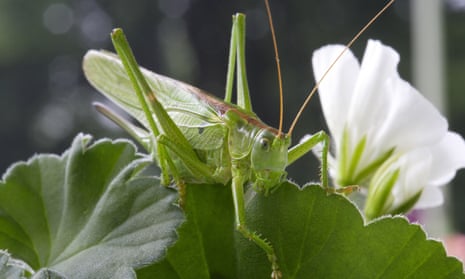Speckled bush-crickets (Leptophyes punctatissima) are prolific in my garden. The nymphs hatch in May and I often spot them sunning themselves on bramble or nettle leaves. During the summer they become rather elusive, moving deeper and higher into the vegetation. But come autumn the humpbacked, spindly-legged, adults reappear.
Attracted to light they often stray indoors and I find them scaling my bedroom walls. Bush-crickets are crepuscular, becoming active in the late afternoon and singing into the night. They are more closely related to grasshoppers than crickets. However, unlike grasshoppers, which rub a row of stridulatory pegs on the inside of the hind legs against their forewings, bush-crickets stridulate by chafing their forewings together.

The bush-crickets’ abrupt chirping is higher pitched than that of grasshoppers and in the case of the speckled bush-cricket beyond the range of hearing for many people, though on still evenings I can just about detect it.
From August to October, the stand-out performer in my garden orthoptera orchestra is the great green bush-cricket (Tettigonia viridissima). There’s no mistaking their strident, sewing-machine-like stridulation, but their song is ventriloquial and, despite being over three times the size of Leptophyes punctatissima, they are fiendishly difficult to locate. Their emerald-green coloration closely matches the leaves and grasses they live among, giving them the ability to hide in plain sight.
The last place I expected to discover one was in my kitchen. It was her beady eye peering out from between the foliage of a potted basil that gave her away. The long, scimitar-shaped, appendage at her rear – an ovipositor, used to deposit eggs in the ground – identified her as female.
At almost 5cm long, with antennae exceeding her body length, she certainly lived up to her name. Her veined wings were exquisite, reminding me of an unripe, folded sycamore key. As I parted the stems to get a better look she burst out of the plant, vaulting over the counter.
Lunging forward I cupped her in my hands. As I carried her outside, I felt her legs tense like compressed springs, then a searing pain as she sunk her jaws into my palm.
Follow Country diary on Twitter: @gdncountrydiary

Comments (…)
Sign in or create your Guardian account to join the discussion